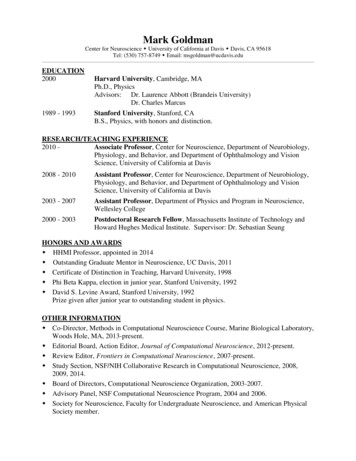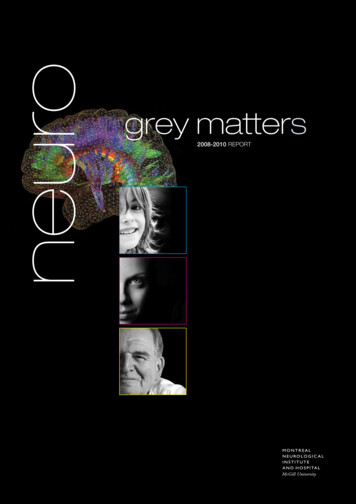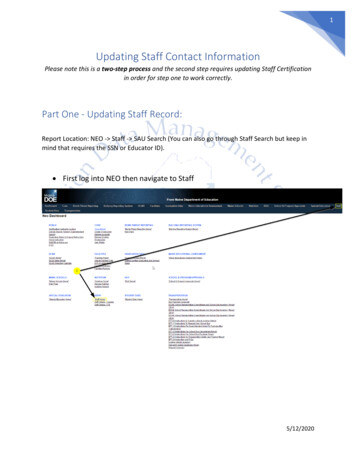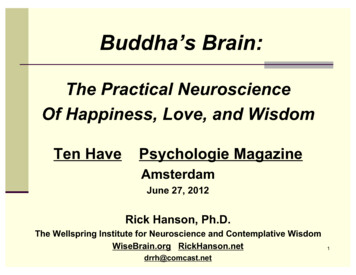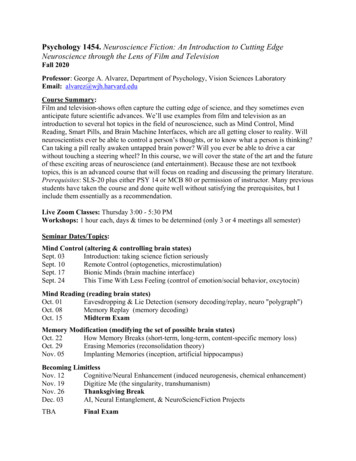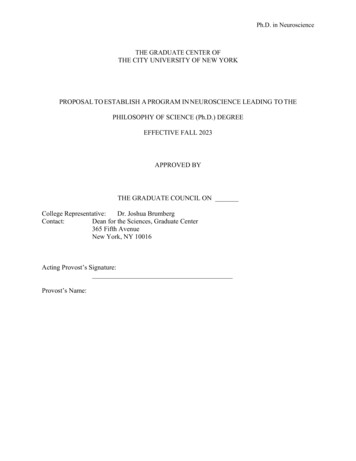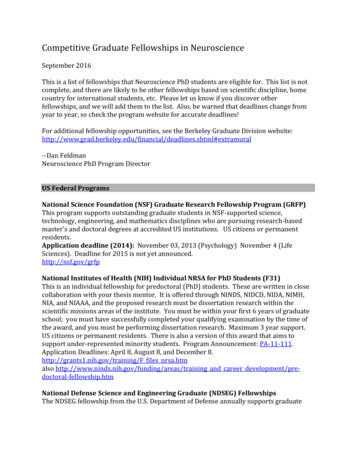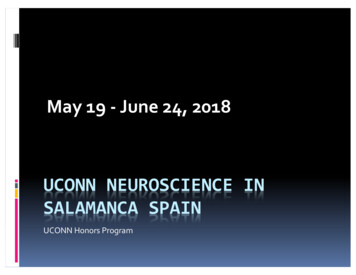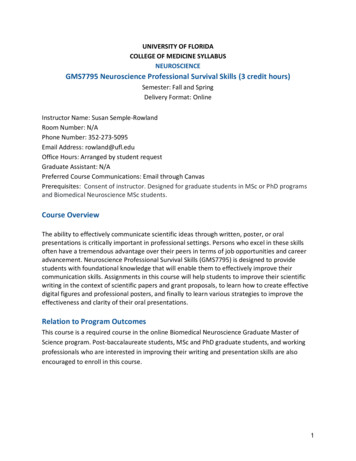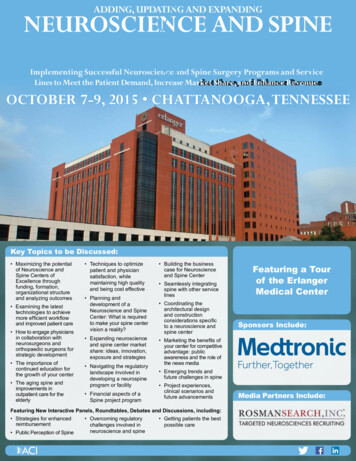
Transcription
ADDING, UPDATING AND EXPANDINGAdding, Updating and Expanding Neuroscience and Spine Centers of Excellence for Hospitals and Health SystemsOctober 7-9, 2015 Chattanooga, TennesseeNEUROSCIENCE AND SPINECENTERS OF EXCELLENCEFOR HOSPITALS AND HEALTH SYSTEMSImplementing Successful Neuroscience and Spine Surgery Programs and ServiceLines to Meet the Patient Demand, Increase Market Share, and Enhance RevenueOctober 7-9, 2015 Chattanooga, TennesseeKey Topics to be Discussed: Maximizing the potentialof Neuroscience andSpine Centers ofExcellence throughfunding, formation,organizational structureand analyzing outcomes Examining the latesttechnologies to achievemore efficient workflowand improved patient care How to engage physiciansin collaboration withneurosurgeons andorthopaedic surgeons forstrategic development The importance ofcontinued education forthe growth of your center The aging spine andimprovements inoutpatient care for theelderly Techniques to optimizepatient and physiciansatisfaction, whilemaintaining high qualityand being cost effective Planning anddevelopment of aNeuroscience and SpineCenter: What is requiredto make your spine centervision a reality? Expanding neuroscienceand spine center marketshare: ideas, innovation,exposure and strategies Navigating the regulatorylandscape involved indeveloping a neurospineprogram or facility Financial aspects of aSpine project program Building the businesscase for Neuroscienceand Spine CenterFeaturing a Tourof the ErlangerMedical Center Seamlessly integratingspine with other servicelines Coordinating thearchitectural designand constructionconsiderations specificto a neuroscience andspine centerSponsors Include: Marketing the benefits ofyour center for competitiveadvantage: publicawareness and the role ofthe news media Emerging trends andfuture challenges in spine Project experiences,clinical scenarios andfuture advancementsMedia Partners Include:Featuring New Interactive Panels, Roundtables, Debates and Discussions, including: Strategies for enhanced Overcoming regulatory Getting patients the bestreimbursementchallenges involved inpossible careneuroscience and spine Public Perception of SpineTel: 312 780 0700 Fax: 312 780 0600 Web: www.acius.net @ACI US
Adding, Updating and Expanding Neuroscience and Spine Centers of Excellence for Hospitals and Health SystemsOctober 7-9, 2015 Chattanooga, TennesseeConfirmed Speakers:Content & Theme:Kevin M. Spiegel, FACHE, President and ChiefExecutive OfficerErlanger Health SystemACI is excited to announce our upcoming Adding, Updating and ExpandingNeuroscience and Spine Centers of Excellence conference October 7-9, 2015.You will not want to miss this opportunity to learn from, and network with,representatives from organizations nationwide that are prepared to deliversuperior service to a growing population.Bob Reznik, MBA, PresidentPrizm Development, Inc.Patrick Vega, MS, Client Executive DirectorStryker Performance SolutionsMichael Graham, MHSA, Client ExecutiveStryker Performance SolutionsErin Bonwit, MBA, BSN, RN, Stroke NurseFlorida Hospital Neuroscience InstituteCherlynn Basigani, Clinical Research ManagerFlorida Hospital Neuroscience InstituteFrank Hellinger, MD, Neurosurgery MedicalDirectorFlorida Hospital Neuroscience InstituteIndrani Acosta, MD, Neurology Medical DirectorFlorida Hospital Neuroscience InstituteAlkesh Brahmabhatt, DO, Assistant MedicalDirector of Flight & EMS ED Stroke CoordinatorFlorida Hospital Neuroscience InstituteDaniel Kueter, MD, NeurosurgeonErlanger Health SystemThis year’s conference will highlight and discuss a myriad of topics that arerelevant to providing ideal patient care. Topics of interest that will be introducedand discussed are the use of new technology, overcoming reimbursement issues,as well as ways to improve your treatment options in an effort to provide themost efficient and high quality patient care. Mastering these variables willensure quick, cost efficient and effective treatment at your Neuroscience andSpine Center.Embrace this opportunity to network and learn from the top neurologyand orthopaedic spine executives and administrators as they speak on thedevelopment and success of their own managerial models. Learn how to dowhat it takes to become a Neuroscience and Spine Center of Excellence anduncover your center’s true potential. Our conference is focused on exploringthe latest developments to increase patient volume, improve outcomes andexcel in total patient care.Explore techniques to better equip your neuroscience and spine center withthe latest strategies and advancements in medical technology through realcase studies, research findings and organizational models from renownedneuro and spine programs. Register for this exclusive industry conference tolearn strategies from the top industry leaders and innovators.Peter DeRosa, MD, NeurosurgeonInova Health SystemSteve Samples, MD, Vice Chair of RegionalNeurosciencesCleveland ClinicTara Schubert, Administrator for the Center forRegional NeurosciencesCleveland ClinicWho Will Attend: Presidents & CEO’sJudy Rosman, PresidentRosmanSearch, Inc.Jeffrey Carlson, MD, President and ManagingPartnerOrthopaedic and Spine CenterRick Shumway, MHA, Executive DirectorThe University of Utah Hospitals & ClinicsBeth Armstrong, Senior Director, Operations,Neuroscience Service LineOhioHealthJanet Bay, MD, NeurosurgeonOhioHealth Chief Operations Officers Administrative Directors of Neurology and Orthopaedics Vice Presidents/Directors of Business Development and Strategic Planning Chief Medical Directors Spine Surgeons/Neurosurgeons Chief Administrators Directors/VPs Pain Management ServicesBarbara Mancini, Neuroscience Service LineDirectorInova Health System Directors/Managers of Physical Medicine and RehabilitationSylvia Marten, PresidentVeritas Health LLC, Spine-Health Neuroscience Service Line DirectorsCheryl Zapata, Chief Development OfficerTexas Back InstituteTel: 312 780 0700 Vice Presidents/Directors of Neuroscience and Spine Services Directors of Neuro Critical CareFax: 312 780 0600 Web: www.acius.net @ACI US
Adding, Updating and Expanding Neuroscience and Spine Centers of Excellence for Hospitals and Health SystemsOctober 7-9, 2015 Chattanooga, TennesseePre-Conference Interactive Session October 7, ference Interactive Session - ESTABLISHING AND MAINTAINING A COMPETITIVEADVANTAGE IN YOUR NEUROSCIENCE & SPINE SERVICE LINESInformation and stakeholder alignment are keys to competitively positioning a Neurosciences & Spine Service Line. Data can be leveraged to guideprogram development, drive outcomes, and foster accountability. Along with transparency and open, timely communication, data is a powerful toolthat can be used to engage discussion among key stakeholders and establish alignment among physicians, staff, and leadership.Key issues to be covered include how to: Identify data and use data elements toposition a Neurosciences & Spine ServiceLine for success Engage key stakeholders through data and aclear communication plan Create a structure of accountability aroundmeaningful metricConference Day One October 8, 2015:7:45AM-8:30AMREGISTRATION AND CONTINENTAL BREAKFAST8:30AM-8:45AMWELCOME & CHAIRPERSON’S OPENING ADDRESS8:45AM-9:45AMErlanger Neuroscience Center of Excellence - Past, Present, and FutureProvide an overview of Erlanger’s development and implementation of a Regional Operations Center (EROC) and how it has streamlinedcommunications and allowed for continuation of a successful stroke program, without a building. Will also discuss business development andregional growth as a result of placing business development staff in the region. Growth also due to the implementation of a no divert and autoaccept policy. Explain how the recent acquisition of a neurosurgery group has increased growth and market share. The future of Erlanger andthe journey to building a new Neuroscience Center.Attendees will learn how to: Facilitate throughput and flow and run asuccessful stroke program without anactual building Streamline Processes Strengthen Relationships Increase Regional PresenceKevin M. Spiegel, FACHE, President and Chief Executive OfficerErlanger Health SystemKevin M. Spiegel, FACHE, serves as President & CEO for the Erlanger Health System in Chattanooga, Tennessee. In his current role, the seasoned healthcare executiveoversees the tenth largest public health system in the United States. Mr. Spiegel is a Board Certified Healthcare Executive and a Fellow of the American Collegeof Healthcare Executives. Mr. Spiegel joined Erlanger April 2013, after serving over five years as CEO at Methodist University Hospital in Memphis, where he alsoserved as an assistant professor in the College of Medicine and continues in that role today. Mr. Spiegel is the first pre-hospital care provider to hold the office ofPresident & CEO of Erlanger Health System. Currently, Mr. Spiegel serves as a Regent for Tennessee with the American College of Healthcare Executives and anAssistant Professor in the College of Medicine at the University of Tennessee.9:45AM-10:00AMMORNING REFRESHMENT BREAK & EXHIBITS10:00AM-11:00AMHOW TO DEVELOP A DESTINATION FOR SPINE CARE IN THE CURRENT HEALTHCARE REFORMENVIRONMENTA destination center for spine care – as perceived by the employer, payer or patient – is NOT a group of surgeons wanting more surgeries, injectionistswanting more injections or a hospital wanting to fill more beds. A destination center for spine care changes the product design so a multi-disciplinaryteam of spine specialists can eliminate fragmentation and improve communication. By improving the spine product, the consumer receives optimalcare, the employer sees a faster return to work, and the payer sees a predictable (case rate) price for the documented clinical outcomes. A spinecenter of excellence is not INCLUSIONARY as that replicates the current problem with spine care today. A spine center achieves excellence byEXCLUDING mediocre providers. This is the future of spine care.Attendees will learn: How to develop a spine care PRODUCTthat appeals to, consumers employers, casemanagers and payers. What to includeand, more importantly, what to exclude How to PRICE spine care with case ratesfor spine surgery, spinal injections andnon-surgical episodes of care How to PLACE the product in the marketplacewith a spine center facility that is unique andconsolidates a team of specialists and keycomponents under one roof Trap doors to failure: (if it were easy, anyonecould do it.) Why some spine centers fail togrow How to POSITION the spine center assuperior to competitors and establishbarriers to entry to competitors How to PROMOTE the destination center viathe internet, direct-to-consumer promotionand referral development to attract patientsfrom a 300 mile radiusBob Reznik, MBA, PresidentPrizm Development, Inc.Prizm Development, Inc. was founded in the mid-1990s by Bob Reznik who holds an MBA specialized in healthcare and quality management systems. Reznik hasauthored four books on healthcare subjects and is a nationally recognized expert and speaker on center of excellence development. He was chose by the AmericanAssociation of Neurological Surgeons (AANS), World Research group, the International Spinal Intervention Society (ISIS) and other groups as a speaker on centerof excellence development. Prizm and its center of excellence approach to spine has been cited as a leader in the recent textbook, Redefining Healthcare, whichexamines those entities that are leading the evolution of healthcare in the United States. With more than 25 year’s experience in spine center development, no onein the world has as much experience in the niche of spine center development.Tel: 312 780 0700 Fax: 312 780 0600 Web: www.acius.net @ACI US
Adding, Updating and Expanding Neuroscience and Spine Centers of Excellence for Hospitals and Health SystemsOctober 7-9, 2015 Chattanooga, Tennessee11:00AM-12:00PMBuilding blocks a comprehensive spine care OF THE FUTUREThe presentation will focus on the essential elements of a comprehensive spine program. Changes in spine care reimbursement, treatment settings and theimpact of payer-led initiatives to define quality have altered expectations for the delivery of coordinated non-operative and surgical spine care. The presenterswill identify common barriers to effective development of a comprehensive spine service line and explore the elements of a successful service line.Attendees will learn: Industry trends that are influencing thedelivery and reimbursement of spine care Opportunities to incorporate andleverage Physiatry & Non-Surgical Spine How to define and offer “comprehensive”spine care within your community Best practices to engage your key spinecare providers How to understand and assess the spinecare assets and gaps within yourorganizationPatrick Vega, MS, Client Executive DirectorStryker Performance SolutionsAs a Client Executive, Patrick partners with physician leadership and hospital C-suite customers to align their needs with the most appropriate and impactful StrykerPerformance Solutions offering. His broad expertise in assessment, planning and implementation, coupled with highly developed abilities in physician relations, has broughtsuccess to his customers. Patrick joined SPS after more than eight years as Principal for Vega Healthcare, where he conducted strategic assessment and planningin orthopaedics, neurosciences, and spine. He also consults, writes and speaks about orthopaedics, neurosciences, and spine. Patrick earned his Bachelor of Artsdegree in Speech Communications from San Diego State University and his Master of Science degree in Counseling from California State University at Fullerton.Michael Graham, MHSA, Client ExecutiveStryker Performance SolutionsMike Graham joined Stryker Performance Solutions in 2014 as a Client Executive Director for the Mid-Atlantic region. Drawing upon 20 years of healthcare experience,Mike works with physician and hospital leaders to align opportunities in the development of their Orthopaedic and Spine service lines. Before joining Stryker, Mike directedoperations at Priority Consult, a medical software company he helped create in 2002, which provided infrastructure for Spine, Neuroscience and Oncology centers acrossthe country. In that capacity, Mike was personally involved in the creation of more than 70 hospital-based spine programs. Prior to that, he helped develop andmanage the patient intake and care coordination department at Mayfield Clinic & Spine Institute in Cincinnati, OH. Mike has a degree in Management InformationSystems from the University of Dayton and a Masters in Health Administration from Xavier University.12:00PM-1:00PMLUNCHEON FOR DELEGATES AND SPEAKERS1:00PM-2:15PMPANEL DISCUSSION: STREAMLINING STROKE PROCESSES TO ACHIEVE WORLD CLASS OUTCOMESIN DOOR TO TREATMENT TIMES WITH HOSPITALS UTILIZING TELEMEDICINE AS A PRIMARYMETHOD OF EVALUATING STROKE PATIENTSAs a large comprehensive stroke center who utilizes telemedicine for all stroke patients, we needed to find a way to streamline our process in order toimprove patient outcomes who receive mechanical thrombectomy. We want to ensure we are consistently achieving our goal of door to treatment in 90 minutes. We implemented a dedicated stroke nurse that is responsible for coordinating the care of stroke patients from the ED to IR (if they qualify).Implementing this role, has provided constancy within the hospital system, increased patient volume, decreased door to treatment times, decreasedlength of stay, and improved patient outcomes. We have shifted from a sequential workflow process to a parallel workflow process by unitingmultiple key departments needed in stroke care, which resulted in a reduction of our door to treatment times of 50 minutes year to date.Attendees will learn how to: Utilizing a highly trained stroke nurse tocoordinate care Convert a sequential workflow process toa parallel workflow process in order toexpedite treatment Decrease treatment times, length of stay,and improve patient outcome by unitingkey departments (ED, imaging, IR)Erin Bonwit, MBA, BSN, RN, Stroke NurseFlorida Hospital Neuroscience InstituteErin started her career as an Emergency Room nurse, moving into management within the Emergency Department. She then transferred over to Neuroscience Researchinvolved with the recently published stroke trail SWIFT PRIME. Most recently Erin has developed an acute stroke nursing role within her hospital system to improve theirprocess and outcomes related to stroke care.Cherlynn Basigani, Clinical Research ManagerFlorida Hospital Neuroscience InstituteCherlynn Basignani is a dedicated registered nurse (RN) with specialty experience in neurovascular and cardiovascular research, emergency, critical care adult andpediatrics, and continuing medical and nursing education. She has thirty-five years of nursing experience in hospital, academics, and private practice. As the ClinicalResearch Manager and Acting Director of Florida Hospital’s Neuroscience Research, she has experience working on grants, physician initiated trials, as well as pharma,device, and biological sponsored trials (Covidien, Abbott, Medtronic etc.). She is published in Neurocritical Care and Journal of American Medical Association. Herfocus area is on quality care, easy access to care and positive patient/family experience. She works to move the health care continuum to spend more time inpreventing the disease then in the acute phase of treating the disease.Frank Hellinger, MD, Neurosurgery Medical DirectorFlorida Hospital Neuroscience InstituteDr. Hellinger was at the Massachusetts General Hospital of Harvard Medical school from 1990-1998. While there he completed a residency in radiology and a fellowshipin diagnostic and interventional neuroradiology. He was Co-Director of Interventional Neuroradiology when he moved to Florida Hospital in Orlando where he has beenDirector of Interventional Neuroradiology since then. In Orlando, he has partnered with Florida Hospital to build a comprehensive practice in Interventional Neuroradiologyincluding participation in numerous neuroendovascular research trials.Indrani Acosta, MD, Neurology Medical DirectorFlorida Hospital Neuroscience InstituteAlkesh Brahmabhatt, DO, Assistant Medical Director of Flight & EMS ED Stroke CoordinatorFlorida Hospital Neuroscience InstituteAttending Emergency Department physician at Florida Hospital for over 12 years. Currently the ED Stroke Director at the Florida Hospital Orlando comprehensive strokecenter Emergency Department since 2012. Board Certified emergency medicine doctor since 2000. Also the current Assistant Director of the Florida Hospital Flight andEMS system since 2013. Former Assistant Director of the Emergency Room of Florida Hospital Altamonte Springs and Florida Hospital Zephyrhills. Former EmergencyDepartment Unit Director of FH Altamonte Springs.Tel: 312 780 0700 Fax: 312 780 0600 Web: www.acius.net @ACI US
Adding, Updating and Expanding Neuroscience and Spine Centers of Excellence for Hospitals and Health SystemsOctober 7-9, 2015 Chattanooga, Tennessee2:15PM-3:00PMPAST, PRESENT AND FUTURE OF SPINE SURGERY: STAYING AHEAD OF THE CURVEProvide an overview of the history of spine surgery, new technologies, current procedure techniques, and what new upcoming technologies andprocedures are upcoming.Attendees will learn how to: History of Spine Surgery Program development and implementation Current State of Spine Surgery; currentprocedure methods, technology, protocol, etc Future of Spine Surgery; procedure methods,technology, protocol, etcDaniel Kueter, MD, NeurosurgeonErlanger Health SystemDr Daniel Kueter was born in Arkansas and went to Jonesboro High School, graduation in 1992. He received his Eagle Scout award and was active in the trackand cross country programs. He performed his undergraduate studies at Christian Brothers University in Memphis, TN, receiving his degree in 1996 with MagnaCum Laude honors. He attended medical school at the University of Arkansas, and received his MD in 2000. For Neurosurgical residency, he was accepted into the University of Tennessee Medical system in conjunction with the Semmes Murphey clinic. He completed his neurosurgery residency in 2006. His trainingemphasized minimally invasive treatment of spinal disorders as well as complex adult skull based neurosurgery. Dr Kueter arrived in Chattanooga in 2006 and hasbeen employed with Chattanooga Neurosurgery & Spine, which is now known as UT Erlanger Neurosurgery Group, since that time.Track One:3:00PM-3:15PMTRANSPORTATION TO TOUR3:15PM-4:30PMEXCLUSIVE SITE TOUR: ERLANGER MEDICAL CENTERThe Southeast Regional Stroke Center at Erlanger, a part of Erlanger Health System’s Neurological Center, is Southeast Tennessee’s firstand only accredited Comprehensive Stroke Center. Erlanger earned the Gold Seal of Approval from The Joint Commission, recognizing thatErlanger follows national standards and guidelines that can significantly improve outcomes for stroke patients. We were recently recognizedas the top enrolling center and received the award for the best patient outcomes in a clinical trial that changed the standard of stroke care.The tour will include: Tour of the Interventional RadiologyDepartment Tour of the Life Force Helicopter Hanger Tour of the Emergency DepartmentTrack Two:3:00PM-4:30PMWORKSHOP: BECOMING A SPINE CENTER OF EXCELLENCEThis workshop will discuss how to become a designated Spine Center of Excellence. Attendees will walk away with the knowledge necessaryto transform their facilities into Centers of Excellence.Peter DeRosa, MD, NeurosurgeonInova Health System5:00PMEND OF CONFERENCE DAY ONEConference Day Two October 9, 2015:7:45AM-8:30AMREGISTRATION AND CONTINENTAL BREAKFAST8:30AM-8:45AMWELCOME & CHAIRPERSON’S OPENING ADDRESS8:45AM-10:00AMDEVELOPMENT OF A COMPREHENSIVE NEUROSCIENCE SYSTEM USING THIS VALUE BASEDAPPROACHSteve Samples, MD, Vice Chair of Regional NeurosciencesCleveland ClinicStephen D. Samples, M.D., is Vice-Chairman of the Neurological Institute and a member of the Neurological Institute’s Strategic Finance Team. Dr. Samples isDirector of the Center for Regional Neurosciences and General Neurology. Dr. Samples began the Center for Regional Neurosciences in 2007. Today, the Centeremploys 35 neurologists and 8 neurosurgeons throughout the Cleveland Clinic Enterprise. In addition to Center Director, Dr. Samples has initiated the Consultationand Affiliate Program for the Neurological Institute providing expertise in Neurosciences both nationally and internationally. Dr. Samples is also the architect of theCleveland Clinic Healthcare 101 course. The course was designed to educate physicians and nurses about the business of healthcare in the changing medicalenvironment. Dr. Samples received his medical degree from The University of Texas Health Science Center at San Antonio.Tara Schubert, Administrator for the Center for Regional NeurosciencesCleveland ClinicTara Schubert is the Administrator for the Center for Regional Neurosciences at the Cleveland Clinic. Tara has been with the Cleveland Clinic for 9 years. Shestarted her career working with community practice physicians and assisted with their integration to the Cleveland Clinic. She has experience with the adaption ofCCF clinical standards and policies. Tara has the day-to-day responsibility of operations in the Center for Regional Neurosciences. Tara is also responsible for theNeurological Institute’s Consultation and Affiliation Program. She has worked with hospitals in the US and internationally to help design Comprehensive NeurosciencePrograms focusing on Quality, Outcomes and Care Paths. Tara also helped to design and implement the Cleveland Clinic Healthcare 101 course. The course wasdesigned to educate physicians and nurses about the business of healthcare in the changing medical environment.Tel: 312 780 0700 Fax: 312 780 0600 Web: www.acius.net @ACI US
Adding, Updating and Expanding Neuroscience and Spine Centers of Excellence for Hospitals and Health SystemsOctober 7-9, 2015 Chattanooga, Tennessee10:00AM-10:30AMMORNING REFRESHMENTS10:30AM-11:15AMHow to Recruit the Neurosurgeons and Neurologists You Need to Build YourNeuroscience and Spine Center of ExcellenceRecruiting neurosurgeons and neurologists can be a difficult, complex recruitment. Learn how neurosurgeons and neurologists evaluate theirjob opportunities so that you can make sure your own recruitment is set up for success! In addition, learn strategies for sourcing, referencechecking and closing the deal with the neurosurgeon or neurologist you need to build your neuroscience and spine program.Attendees will learn: Understand how neurosurgeons andneurologists evaluate job opportunities How to evaluate whether your offer iscompetitive in today’s hiring market How to use recruitment incentivesappropriately to overcome tricky issues liketail insurance for mid-career candidatesand to make an offer more attractive Develop a strategic plan for recruiting anddevelopment of a successful practice thatwill leave candidates impressed with thequality of the opportunity Ensure you have the buy-in from thosenecessary to make the recruitmentsuccessful Develop a pool of qualified and interestedcandidates Understand the impact of trends such ashospital employment and the importanceof the employment model and reportingstructures Understand the most important factors inretention of your new neurosurgeon orneurologist Use the telephone interview to make agreat first impression Create a warm, hospitable and meaningfulsite visit experience that will makecandidates want the job Know how and when to check referencesand to understand the interconnectedworld of specialists Protect themselves from making costlymistakes by hiring the wrong people Work with multiple candidatessimultaneously to seal the dealJudy Rosman, PresidentRosmanSearch, Inc.Judy Rosman is President of RosmanSearch, Inc., a recruitment firm specializing in neurosurgical and neurological recruitment. She graduated from the University ofVirginia Law School, where she had a dual specialty in Tax Law and Health Law and was the recipient of the Charles Frankel Award in Health Law. She worked as anattorney for one of the top law firms in Missouri before relocating to Ohio and starting her own company. Judy has been a featured speaker at national neurosurgeryconferences and courses for neurosurgery residents and practicing neurosurgeons. Her articles have been published in the Journal of Medical Practice Managementand, most recently, she was first author on the largest neurosurgery workforce study, published in the Journal of Neurosurgery, which examined the question of whetherthere is a true shortage of neurosurgeons and the demand ratio commonly used to assess community need for neurosurgery is correct.11:15AM-12:00PM NAVIGATING THE CHANGING LANDSCAPE OF NEUROSCIENCES ECONOMICSThis presentation will help attendees to better understand the complex economic challenges that will impact Neurosciences Service Lines/Centers/Institutes in the coming years. Using national trends, new payor models, and operational strategies that are underway at the University of Utah’sClinical Neurosciences Center, the presentation will focus on “real life” opportunities to be successful in this new economic environment.Attendees will learn how to: Identify key changes that are anticipated to impact NeurosciencesService Lines/Centers/Institutes in the coming years Learn about “real life” solutions implemented at the University ofUtah in meeting these challenges Identify key strategies and tactics to implement that will improvethe ability of a service line/center/institute in remaining financiallyviable within the new economic constructRick Shumway, MHA, Executive DirectorThe University of Utah Hospitals & ClinicsRick Shumway, MHA is the Associate Executive Director at University of Utah Hospitals & Clinics. His oversight includes the health system’s Perioperative Services,Trauma Services, Imaging Services, Supply Chain Services, as well as the Clinical Neurosciences Center (CNC). The CNC has been designated a national NeuroscienceCenter of Excellence, and is the recognized leader in the Neurosciences within the Intermountain Region. The center offers expertise and service to patients throughoutthe Intermountain West, and its catchment area is comprised of over 10% of the contiguous United States. Prior to joining University of Utah Health Care, Rick workedin several senior level administrative positions at the University of Pittsburgh Medical Center (UPMC) in Pittsburgh, PA, as well as at the University of WashingtonMedical Center in Seattle, WA.12:00PM-1:00PMLUNCHEON FOR DELEGATES & SPEAKERS1:00PM-1:45PMMAKING THE MOST OF HOSPITAL & PHYSICIAN RELATIONSHIPSThis conference will discuss physician and hospital relationships and how to maximize the benefits for all parties.Attendees will learn how to: Discuss relationships with hospitals andphysicians Analyze hospital-physician relationships Finalize hospital-physician relationshipsJeffrey Carlson, MD, President and Managing PartnerOrthopaedic and Spine CenterDr. Jeffrey Carlson joined OSC in 1999, and serves as the President and Managing Partner. He is a board-certified, fellowship-trained spine specialist who focuses onthe treatment of injuries and disorders of the spine. Dr. Carlson also sees patients for a wide variety of general orthopaedic issues and problems and favors conservativetreatment for his patients. He is a thought leader and pioneer in the development and implementation of outpatient spinal surgery procedures and techniques, includingLess-Exposure Spine Surgery (LESS), which is minimally invasive, and less tr
of Healthcare Executives. Mr. Spiegel joined Erlanger April 2013, after serving over five years as CEO at Methodist University Hospital in Memphis, where he also served as an assistant professor in the College of Medicine and continues in that role today. Mr. Spiegel is the first pre-hospital care provider to hold the office of
